NCAA, College Football
South Florida vs UTSA: Matchup Guide and Score Outlook
FlagOh’s guide to South Florida vs UTSA gives you what you need at a glance—kickoff and TV info, a quick weather check, and likely availability—then breaks down the real swing factors (tempo, explosive plays, red-zone finishing) and ends with a clear, no-noise score outlook.
How to Watch South Florida vs UTSA
South Florida vs UTSA lands in a weeknight Tampa slot, and this match-context hub puts everything in one glance—kickoff window, where to watch, venue setting, weather tone, and a quick market read—so you can focus on the football instead of hunting for basics.

| Item | USF hosts UTSA (AAC weeknight game) |
| Date & Kickoff | Thu, Nov 6, 2025 — 7:30 p.m. ET / 6:30 p.m. CT |
| Venue | Raymond James Stadium — Tampa, FL |
| TV / Stream | ESPN (stream via ESPN app with authentication) |
| Spread / Total | USF −13.5 to −14; O/U 67.5–68.5 (as of Nov 3) |
| Weather | Mostly sunny ~84°F (29°C); ENE ~5–7 mph; low precip chance |
| Series | UTSA leads 1–0 (49–21 on Nov 17, 2023) |
| Quick pick | Lean USF by 7–14 in most scripts (details below) |
We show consensus ranges, not a single book’s line; numbers vary by operator and may change after publication.
Stadium Arrival Tips
- Mobile-first: Load your mobile tickets in advance and add them to your wallet app; weak reception at gates is common.
- Bags & entry: Most venues use a standard clear-bag policy and walk-through screening. Travel light to speed entry; check the official policy before you leave.
- Comfort plan: Tampa evenings can still feel warm—hydrate, use sunscreen for earlier arrivals, and plan shade by picking aisles with easier airflow.
- Rideshare flow: Post-game demand spikes. Set a meet point outside the immediate exit loop to avoid gridlock and surge pricing.
- Cashless norm: Expect tap-to-pay at concessions; bring a backup card in case your phone battery dips late.
Pre-Kickoff Essentials
- Game shape: Expect a rhythm that rewards clean operations—substitutions on/off the field, play-clock discipline, and crisp communication off the sideline. Sloppy sequencing (late personnel, wasted timeouts) has an outsized cost in a game that can accelerate.
- Hidden yardage: Clean special-teams operation—no penalties, secure catches, smooth snaps—often beats one flashy return. If your average starting field position is even 6–8 yards better across a few drives, the cumulative edge can swing a one-score game.
- End-of-half management: How both staffs handle the final two minutes—timeouts, sidelines, and clock—often decides whether a one-score script holds or stretches. If one side steals a possession here, your scoreboard math changes fast.
You’ve got the lay of the land—time, place, and the small edges that matter before the first snap. If you’re setting up a living-room watch or a small tailgate, a clean team-flag display from FlagOh is an easy way to bring a bit of stadium energy home.
Tactical Matchup Keys and Leverage
South Florida vs UTSA comes down to three things: early-down rhythm, one or two explosives, and red-zone finish.

Early Downs and Tempo
- Win early downs → own the pace: 2nd-and-4 keeps the playbook open; 2nd-and-12 invites heat and predictable calls.
- Offense levers: Use jet motion, quick RPO (run-pass option) glance throws (a fast peek route), and screens. When the running back (RB) releases into a route, it usually means they trust the offensive line (OL) to block. If the RB chips or a tight end (TE) stays in to help, they’re expecting pressure.
- Defense answers: simulated pressures (show 6, rush 4) and late safety rotation to muddy quick reads.
- Tempo & field position: tempo only works after first downs; vary speed (go/no-huddle → freeze → shot). Midfield opens the menu; backed up, use safe outs to breathe.
- TV cues: strings of 4+ yards on 1st down → tempo expands; lots of 2nd-and-long → expect stunts/3rd-down pressure; watch the middle eight for a stolen possession.
Explosives and Red Zone
- How chunk plays happen: stack/bunch releases, motion at the snap, and play-action (especially after turnovers).
- How defenses cap explosives: two-high shells (two deep safeties) with brackets (inside-out double coverage) to force checkdowns.
- Red zone, two games in one:
- High RZ (15–25 yd): quick shots—slants, posts, wheels.
- Low RZ (goal-to-go): Condensed splits, pick/rub concepts, QB keepers, TE pop.
- Stay on schedule after misses: if a deep shot fails, answer with a draw/screen to avoid 2nd-and-long.
- TV cues: frequent pre-snap motion = fishing for leverage; 2–3 TEs near the goal line = power look or play-action leak.
The team that nails those wins, for simple game-day vibes at home, adds a team flag from our store.
South Florida vs UTSA Prediction
This game is likely decided by small, repeatable wins—staying in third-and-manageable, keeping slot timing clean, and avoiding protection calls that pull a receiver out of the route. Those levers shape the call more than raw yardage.

Where the margin really comes from
- Win manageable thirds: living in 3rd-and-4/6 keeps the playbook open; long yardage shrinks routes and invites pressure.
- USF rhythm: slot option routes at the sticks move chains; RB releases signal trust in the OL.
- UTSA counter: Win with four off the edge and force TE/RB to stay in, leaving fewer routes on money downs.
- Avoid costly flags: a hold/false start in plus territory often turns points into a field-position trade.
- Short yardage late: USF’s varied 3rd/4th-and-1 calls create space without telegraphing, giving them a fourth-quarter edge.
Model Pick & Game Script
- Control script (low volatility): Efficient early downs limit explosives → USF by ~7–10.
- Swing-play script: A couple of 20+ yard hits or short fields flip leverage → USF by ~3–7.
- Track-meet script: Pace + finishing drives stack TDs → USF by ~10–14, total pushes high-60s.
Pick, score band & flip conditions
South Florida to win. Median range is USF 31–24.
If their tackles hold up without constant chip help and the slot game stays on schedule, a cleaner version pushes toward USF 34–23. The result can tilt the other way if UTSA forces repeated 3rd-and-longs with early edge wins, draws a couple of drive-killing flags, and squeezes points out of special-teams pressure (a blocked/long kick or a field-goal decision pushed into a punt). This is an information-led call, not a betting recommendation.
We lean South Florida, with swing signs to watch including edge pressure, flags in plus territory, and short-field specials. If you’re dressing the viewing space, a clean team flag from FlagOh adds the game-day feel in one easy move.
Series History and Stakes Explained
With South Florida vs UTSA still new on the calendar, this meeting helps set the tone—how the matchup travels, who handles a weeknight prep better, and which identity sticks when the stakes tighten.
All-Time & Last Five
- This is a new pairing—only one prior meeting, played indoors; this edition is outdoors in Tampa.
- The venue shift exposes subtle factors: Travel rhythm, using the correct sideline gate, and communication near the student section.
- After this game, we’ll finally have a real baseline for future comparisons, instead of guessing from a tiny sample.
Trends & Implications
- In a crowded AAC table, head-to-head is a clean tiebreaker—this result can shape each team’s November path.
- A weeknight slot compresses prep and recovery; fourth-quarter legs and special-teams sharpness often reveal how workloads were managed.
- The film from this game will set next year’s talking points: in-game adjustments, sideline operation under TV-window pressure, and the early identity signals of this matchup (not a score/script discussion here).
When the final whistle hits, mark your side with a clean team flag from FlagOh—simple, sharp, and ready for the next chapter.
Market Moves and Game Conditions
Quick cues before kickoff—how the market is pricing the matchup and how on-field conditions/availability might tilt the script.
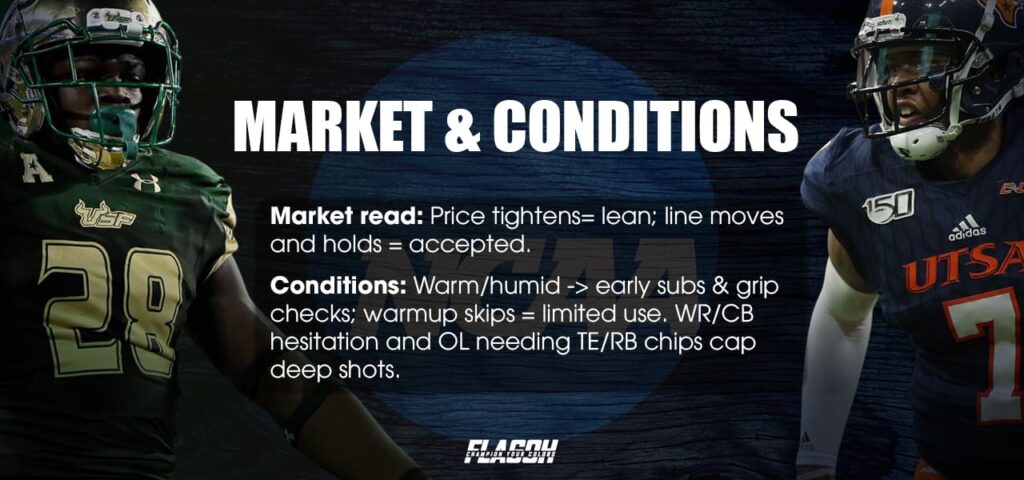
Market Read and Line Signals
- Moneyline = who wins; spread = margin; total = scoring pace.
- If the price tightens while the number stays, the market leans that way. If the number moves and holds while the price steadies, books accept the new level.
- Prioritize simultaneous moves across major books; solo jumps that reverse quickly are noise.
- Track late shifts tied to personnel, tempo, or specialists.
- Use implied probability for shop-to-shop comparisons; ignore tiny ticks.
Field Conditions and Availability
- Warm/humid nights: earlier, more frequent subs; towel/glove swaps; QB (quarterback) –center calibrate early snaps to prevent slips.
- Reading “Questionable” in warmups: Full progression (accel → decel → change of direction → light contact). Skipping final steps = limited or package-only usage.
- WR/CB (wide receiver/cornerback) readiness: clean hip-turn and stop-start = good to go; hesitation = more off-coverage/fewer deep routes. OL without a firm anchor → expect TE/RB chip, reducing routes on must-have downs.
- Special teams: fair catches increase under lights; kickoffs pin corners or use short “mortar” depth; on long FGs, if snap–hold–kick isn’t clean, teams prefer pooch punts or 4th-down tries; inside the 20, use end-over-end (Aussie) roll to control bounce.
South Florida vs UTSA Key Questions
Got a quick question about South Florida vs UTSA? This FAQ cuts straight to the point—kickoff and channel, who’s favored, how to stream, what the weather means, and the matchup most likely to tip the game.
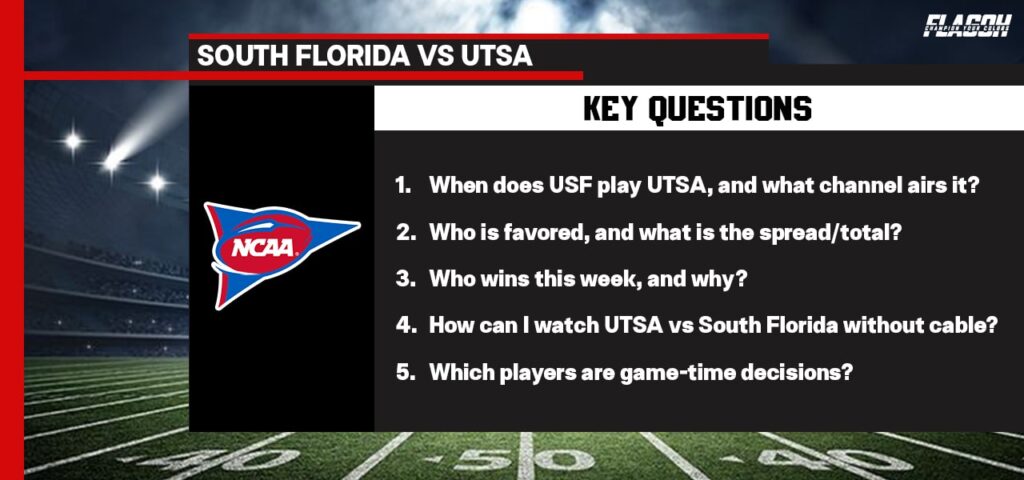
When does USF play UTSA, and what channel airs it?
Thu, Nov 6, 2025 — 7:30 p.m. ET (6:30 p.m. CT) on ESPN; Tampa’s Raymond James Stadium.
Who is favored, and what is the spread/total?
Market snapshots: USF −13.5 to −14; total 67.5–68.5 (check day-of for close with a short, sensible score outlook changes).
Who wins this week, and why?
Our median script leans USF by one score, driven by early-down efficiency and red-zone edge (see “Model Pick & Game Scripts”).
How can I watch UTSA vs South Florida without cable?
Stream via the ESPN app (provider login) or a live-TV service that includes ESPN in your country.
Will wind or rain change the game plan?
Light ENE winds (≈5–7 mph) are below typical disruption thresholds; dry conditions favor standard passing depth and normal FG ranges.
Which players are game-time decisions?
Confirm with team availability reports on game day; snap counts are often managed for first-game returns.
What do advanced stats say (EPA, success rate, pace)?
Use season vs last-4 splits to gauge trend strength; pair efficiency with pace (sec/play) to estimate play volume.
Which matchup will likely decide it (WR1 vs CB1, OL vs DL)?
Explosive pass vs pressure rate and red-zone finishing typically determine separation in high-total games.
Is the smarter angle the spread or the total?
If tempo holds and finishing drives stay strong, total volatility may outpace side volatility; always price-shop and time-stamp your number.
Those are your quick answers in one place. If you’re setting up a watch corner, a clean team flag adds instant game-day energy without any fuss.
In a matchup like South Florida vs UTSA, the edge usually comes from staying on schedule, landing a couple of clean explosives, and finishing red-zone trips. We’ve covered the essentials, the market context, and why a one-score lean makes sense. Ready for kickoff? Set your space and bring a little stadium energy home with a simple team-flag setup from FlagOh.

 Arizona Cardinals Flag
Arizona Cardinals Flag Atlanta Falcons Flag
Atlanta Falcons Flag Baltimore Ravens Flag
Baltimore Ravens Flag Buffalo Bills Flag
Buffalo Bills Flag Carolina Panthers Flag
Carolina Panthers Flag Chicago Bears Flag
Chicago Bears Flag Cincinnati Bengals Flag
Cincinnati Bengals Flag Cleveland Browns Flag
Cleveland Browns Flag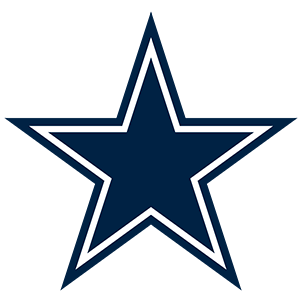 Dallas Cowboys Flag
Dallas Cowboys Flag Denver Broncos Flag
Denver Broncos Flag Detroit Lions Flag
Detroit Lions Flag Green Bay Packers Flag
Green Bay Packers Flag Houston Texans Flag
Houston Texans Flag Indianapolis Colts Flag
Indianapolis Colts Flag Jacksonville Jaguars Flag
Jacksonville Jaguars Flag Kansas City Chiefs Flag
Kansas City Chiefs Flag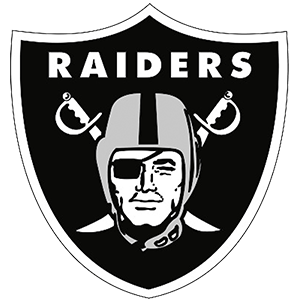 Las Vegas Raiders Flag
Las Vegas Raiders Flag Los Angeles Chargers Flag
Los Angeles Chargers Flag Los Angeles Rams Flag
Los Angeles Rams Flag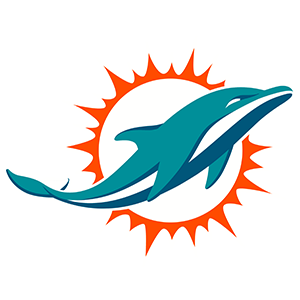 Miami Dolphins Flag
Miami Dolphins Flag Minnesota Vikings Flag
Minnesota Vikings Flag New England Patriots Flag
New England Patriots Flag New Orleans Saints Flag
New Orleans Saints Flag New York Giants Flag
New York Giants Flag New York Jets Flag
New York Jets Flag Philadelphia Eagles Flag
Philadelphia Eagles Flag Pittsburgh Steelers Flag
Pittsburgh Steelers Flag San Francisco 49ers Flag
San Francisco 49ers Flag Seattle Seahawks Flag
Seattle Seahawks Flag Tampa Bay Buccaneers Flag
Tampa Bay Buccaneers Flag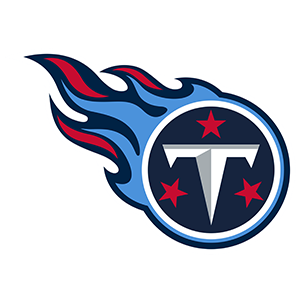 Tennessee Titans Flag
Tennessee Titans Flag Washington Commanders Flag
Washington Commanders Flag Arizona Diamondbacks Flag
Arizona Diamondbacks Flag Atlanta Braves Flag
Atlanta Braves Flag Baltimore Orioles Flag
Baltimore Orioles Flag Boston Red Sox Flag
Boston Red Sox Flag Chicago Cubs Flag
Chicago Cubs Flag Chicago White Sox Flag
Chicago White Sox Flag Cincinnati Reds Flag
Cincinnati Reds Flag Cleveland Guardians Flag
Cleveland Guardians Flag Colorado Rockies Flag
Colorado Rockies Flag Detroit Tigers Flag
Detroit Tigers Flag Houston Astros Flag
Houston Astros Flag Kansas City Royals Flag
Kansas City Royals Flag Los Angeles Angels Flag
Los Angeles Angels Flag Los Angeles Dodgers Flag
Los Angeles Dodgers Flag Miami Marlins Flag
Miami Marlins Flag Milwaukee Brewers Flag
Milwaukee Brewers Flag Minnesota Twins Flag
Minnesota Twins Flag New York Mets Flag
New York Mets Flag New York Yankees Flag
New York Yankees Flag Oakland Athletics Flag
Oakland Athletics Flag Philadelphia Phillies Flag
Philadelphia Phillies Flag Pittsburgh Pirates Flag
Pittsburgh Pirates Flag San Diego Padres Flag
San Diego Padres Flag San Francisco Giants Flag
San Francisco Giants Flag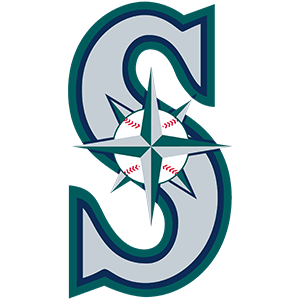 Seattle Mariners Flag
Seattle Mariners Flag St. Louis Cardinals Flag
St. Louis Cardinals Flag Tampa Bay Rays Flag
Tampa Bay Rays Flag Texas Rangers Flag
Texas Rangers Flag Toronto Blue Jays Flag
Toronto Blue Jays Flag Washington Nationals Flag
Washington Nationals Flag Atlanta Hawks Flag
Atlanta Hawks Flag Boston Celtics Flag
Boston Celtics Flag Brooklyn Nets Flag
Brooklyn Nets Flag Charlotte Hornets Flag
Charlotte Hornets Flag Chicago Bulls Flag
Chicago Bulls Flag Cleveland Cavaliers Flag
Cleveland Cavaliers Flag Dallas Mavericks Flag
Dallas Mavericks Flag Denver Nuggets Flag
Denver Nuggets Flag Detroit Pistons Flag
Detroit Pistons Flag Golden State Warriors Flag
Golden State Warriors Flag Houston Rockets Flag
Houston Rockets Flag Indiana Pacers Flag
Indiana Pacers Flag LA Clippers Flag
LA Clippers Flag Los Angeles Lakers Flag
Los Angeles Lakers Flag Memphis Grizzlies Flag
Memphis Grizzlies Flag Miami Heat Flag
Miami Heat Flag Milwaukee Bucks Flag
Milwaukee Bucks Flag Minnesota Timberwolves Flag
Minnesota Timberwolves Flag New Orleans Pelicans Flag
New Orleans Pelicans Flag New York Knicks Flag
New York Knicks Flag Oklahoma City Thunder Flag
Oklahoma City Thunder Flag Orlando Magic Flag
Orlando Magic Flag Philadelphia 76ers Flag
Philadelphia 76ers Flag Phoenix Suns Flag
Phoenix Suns Flag Portland Trail Blazers Flag
Portland Trail Blazers Flag Sacramento Kings Flag
Sacramento Kings Flag San Antonio Spurs Flag
San Antonio Spurs Flag Toronto Raptors Flag
Toronto Raptors Flag Utah Jazz Flag
Utah Jazz Flag Washington Wizards Flag
Washington Wizards Flag Anaheim Ducks Flag
Anaheim Ducks Flag Arizona Coyotes Flag
Arizona Coyotes Flag Boston Bruins Flag
Boston Bruins Flag Buffalo Sabres Flag
Buffalo Sabres Flag Calgary Flames Flag
Calgary Flames Flag Carolina Hurricanes Flag
Carolina Hurricanes Flag Chicago Blackhawks Flag
Chicago Blackhawks Flag Colorado Avalanche Flag
Colorado Avalanche Flag Columbus Blue Jackets Flag
Columbus Blue Jackets Flag Dallas Stars Flag
Dallas Stars Flag Detroit Red Wings Flag
Detroit Red Wings Flag Edmonton Oilers Flag
Edmonton Oilers Flag Florida Panthers Flag
Florida Panthers Flag Los Angeles Kings Flag
Los Angeles Kings Flag Minnesota Wild Flag
Minnesota Wild Flag Montreal Canadiens Flag
Montreal Canadiens Flag Nashville Predators Flag
Nashville Predators Flag New Jersey Devils Flag
New Jersey Devils Flag New York Islanders Flag
New York Islanders Flag New York Rangers Flag
New York Rangers Flag Ottawa Senators Flag
Ottawa Senators Flag Philadelphia Flyers Flag
Philadelphia Flyers Flag Pittsburgh Penguins Flag
Pittsburgh Penguins Flag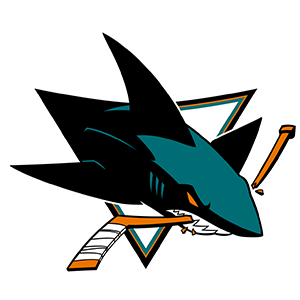 San Jose Sharks Flag
San Jose Sharks Flag Seattle Kraken Flag
Seattle Kraken Flag St. Louis Blues Flag
St. Louis Blues Flag Tampa Bay Lightning Flag
Tampa Bay Lightning Flag Toronto Maple Leafs Flag
Toronto Maple Leafs Flag Vancouver Canucks Flag
Vancouver Canucks Flag Vegas Golden Knights Flag
Vegas Golden Knights Flag Washington Capitals Flag
Washington Capitals Flag Winnipeg Jets Flag
Winnipeg Jets Flag Auburn Tigers Flag
Auburn Tigers Flag Clemson Tigers Flag
Clemson Tigers Flag Florida Gators Flag
Florida Gators Flag Florida State Seminoles Flag
Florida State Seminoles Flag Michigan Wolverines Flag
Michigan Wolverines Flag Nebraska Cornhuskers Flag
Nebraska Cornhuskers Flag Notre Dame Fighting Irish Flag
Notre Dame Fighting Irish Flag Ohio State Buckeyes Flag
Ohio State Buckeyes Flag Oklahoma Sooners Flag
Oklahoma Sooners Flag Oregon Ducks Flag
Oregon Ducks Flag Penn State Nittany Lions Flag
Penn State Nittany Lions Flag South Carolina Gamecocks Flag
South Carolina Gamecocks Flag Tennessee Volunteers Flag
Tennessee Volunteers Flag Texas A&M Aggies Flag
Texas A&M Aggies Flag Texas Longhorns Flag
Texas Longhorns Flag USC Trojans Flag
USC Trojans Flag